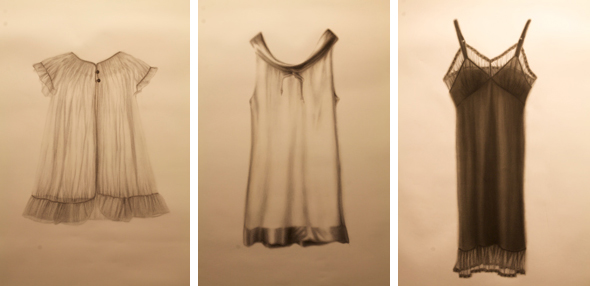Fashion as Fetish
 Unmentionables, Meaghan Olinski
Unmentionables, Meaghan Olinski
My parents have desperately tried to instill in me the value of a dollar. I wouldn’t necessarily say they failed; I just have a very different idea of value and worth. Spending hundreds of dollars on a pair of Burberry flats to me seems reasonable and worth every hard-earned penny, when objectively, the shoes are probably only worth twenty dollars and have a redeemable value of even less.
Despite their best efforts to teach me how to balance a budget, I’ve always looked at money as something imaginary. At such a young age, I was unaware that I shared ideologies similar to Marxist theory; a physical twenty-dollar bill isn’t really worth twenty dollars, it’s merely a representation. Watching my parents hand over plastic credit cards only contributed to my delusions that money wasn’t real; therefore, what was the harm in constantly spending it? Money is of no value until it takes the material form of a designer handbag.
The power these opulent objects have over my finances, and my rationality, is worrisome. My fetish for high fashion extends beyond a love for reading Vogue, becoming what Marx coined as commodity fetishism; when social relationships become transformed into relationships between things. These objects gain their power because slaves of fashion, like myself, give designers this control. If enough people acknowledge couture fashion houses as on the cutting edge, then it becomes an unspoken reality that they are superior to the mainstream and are worth paying more for.
Fashion as a fetish was first conceptualized by Sigmund Freud, who sexualized objects in attributing human qualities to inanimate things. This notion is visible not only in advertisements of fashion houses (none of the models are ever fully clothed), but also the ways in which designers market and brand themselves. A piece of clothing is no longer recognized for the value of its practicality or material, but for the ways it constructs a person’s identity.
In my case, the identity I fetishized was the porcelain-skinned, thin model with voluminous blonde hair. It didn’t matter how much money I poured into designer products, I could never make the identity of these beautiful women a reality. Though I am a white, blonde woman, the standards set by the runways were not within my reach. How, then, could they be relatable to women of different ethnicities, shapes and skin colours?
While the fashion industry claims its indifference to skin colour, New York Fashion Week saw the spring 2011 runways filled with 78 per cent Caucasian women. The most prominent and well recognized designer lines, such as Prada, Balenciaga and Chanel showed in Paris and Milan, had no coloured models walk their shows.
Ironically, fashion shows have a tendency towards cultural appropriation to create setting and tone for their runway. Most often, Asian and Spanish landscapes are the backdrop to a hot couture show, yet Asians make up less than 8 per cent and Latinos less than 2 per cent of the models.
When women of other ethnicities are cast in runway shows, it is usually specific to the type of show produced. For example, Louis Vuitton’s spring 2011 line was made of ‘Asian inspired wear’ encompassing silk kimonos and bold floral prints. Thus, a higher number of Asian models were hired to keep the tone continuous and believable.
Cultural theorist bell hooks identified this phenomenon as not simply fetishization of women’s bodies, but a fetishization of coloured women’s bodies, to where they become a product themselves. She suggests that “within commodity culture, ethnicity becomes spice, seasoning that can liven up the dull dish that is mainstream white culture.” This begs the question, is Louis Vuitton celebrating a different culture, or exploiting it? While for some this may be reminiscent of French colonialism, the fashion industry stands strong in saying it is merely using the inspiration of a culture and its landscape.
When an entire culture is used to represent a product or designer, the culture becomes a product in and of itself. Vuitton’s well tailored kimono-inspired dresses suggest Asian culture will be passé next season. The Asian woman becomes a symbol, to be devoured as she walks the runway; there is no differentiation between her and her clothes.
There has been comparable cause for concern within the past few years regarding a lack of African-American women being cast in major shows. Similarly, black women are mostly hired when a designer is using a more rugged theme that embodies their idea of a specific culture or ethnic group.
Though the lack of diversity amid the fashion industry is problematic, the commodification of these ‘diverse’ bodies is ultimately more concerning. An Asian woman becomes another decoration to enhance the eastern theme of a fashion show, as her race becomes her only point of importance to be exploited and consumed. Stemming from an industry that concerns itself with the appearance of people, such a type of blatant commodification can go largely unnoticed.
By looking beyond the cache of a designer name, I’ve discovered the complexity of the industry in its relation to women of all types. The concept of power Marx was so concerned with becomes shifted depending upon who is an active audience to an industry that’s virtually everywhere.
Whether it’s a Caucasian or Asian woman strutting the catwalk, the ultimate objective is to become a symbolic body, representing a theme or an ideal separate from their personal identity. Like twenty-dollar bills, models become priced not based upon their worth, but on their value. When I consume products that instill these constructs, am I consuming this ideology as well? I may not give up my love for the artistry of the industry, but I must question the intentions behind an industry that builds itself upon manufacturing the female body as a product. I may occasionally buy into the power of a product, but I’m not buying into the power they have over my identity.